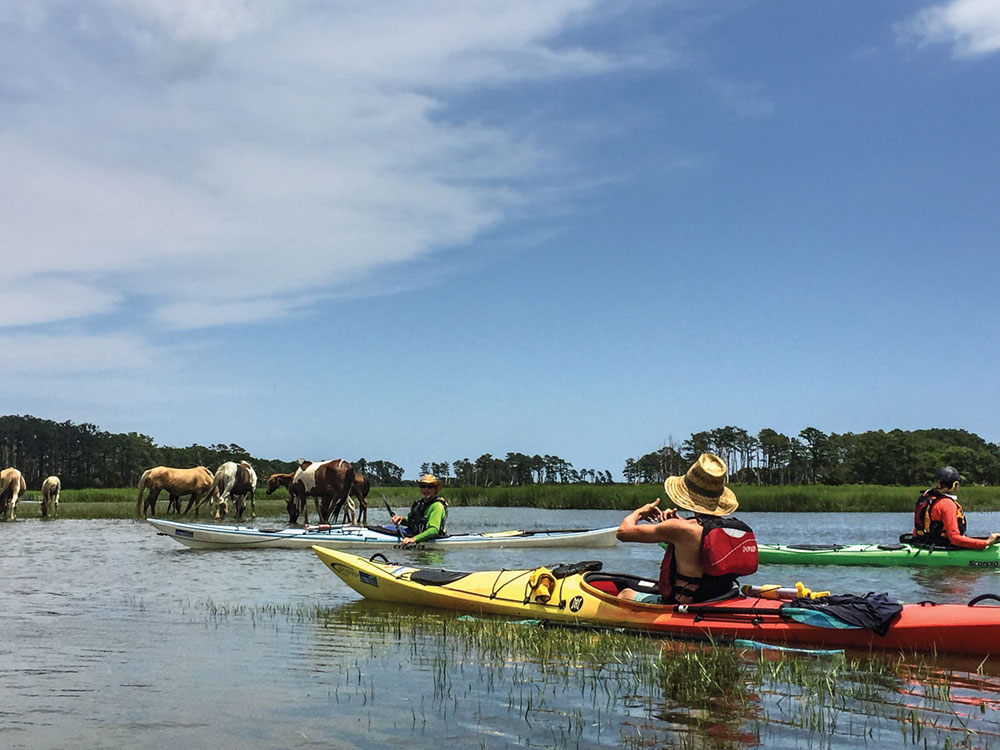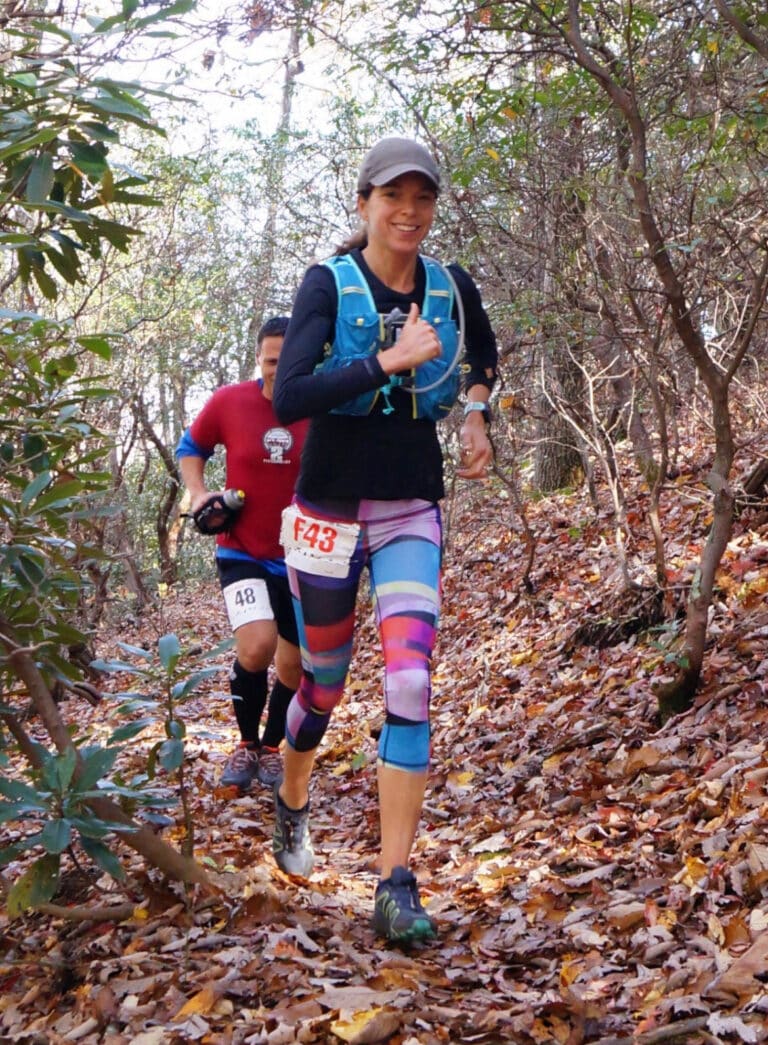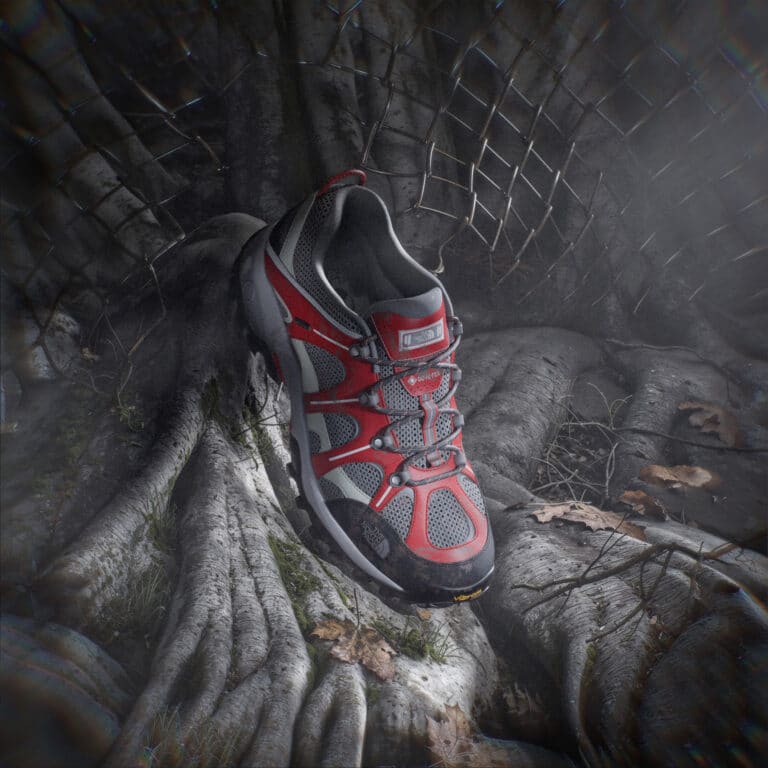Meet the couple behind Burnham Guides, the Onancock-based outfitting company helping paddlers kayak the Eastern Shore’s wild barrier islands.
Bill Burnham dips a paddle into the cool, calm water, whisking his kayak down the narrow, grass-lined channel of Folly Creek. The morning breeze carries smells of salt marsh and ocean, the music of shorebirds, gulls, and dry reeds. We pass muddy banks and submerged oyster clusters, sending thousands of fiddler crabs skittering for burrows. A great blue heron glides overhead; snowy white egrets and glossy ibis comb the shallows for fish.
At this point, we’ve left behind all signs of civilization: We’re utterly alone.

“To me, this is what makes kayaking the Eastern Shore so special,” says Burnham, 51. Vast swaths of protected coastal wilderness can be found within 5 to 10 miles of pretty much anywhere on the peninsula. Most of it is accessible only by boat.
Burnham is intimately familiar with these areas. He and his wife, Mary, are certified ecotour guides and co-own the Onancock-based outfitting company, Burnham Guides. They’ve spent about 15 years leading and assisting long-distance kayaking trips throughout the Shore’s 75-mile mélange of coastal preserves, which constitute the East Coast’s longest expanse of coastal wilderness.
While the Burnhams are happy to lead day trips along wetland estuaries and wild beaches, their specialty is helping kayakers thru-paddle the Virginia Seaside Water Trail. The 100-plus-mile route begins in Chincoteague National Wildlife Refuge on Assateague Island, winds its way through dozens of wild barrier islands, and ends at the Eastern Shore of Virginia National Wildlife Refuge near the peninsula’s southern tip. The trip takes most paddlers five to seven days to complete and, because camping is illegal on most islands, they’ll typically need assistance.
“We’re the only outfitter in the region that does this,” says Bill, who honed his long-distance paddling chops leading kayak-camping trips in the Florida Keys. The Burnhams are the sole commercial outfitter licensed to visit 14 of the Shore’s outermost islands, which total 133,000 acres and are owned by the Nature Conservancy.
“The goal is to help people immerse themselves in these incredible and unsullied coastal ecosystems,” says Mary, 59. Visiting paddlers can expect days of kayaking through quiet bays and winding wetland creeks, encounters with aquatic wildlife like shellfish, blue crabs, and porpoise, chances to spot upward of 400 bird species, and sojourns along miles of solitary beaches—and most of it without encountering another soul.
Like thru-hiking, spending that much time on the water lets “you slow down and notice the minutia and immensity of our ecological diversity,” says Bill. “It helps you really tune in to the beauty and spirit of this amazing place.”

How did Bill and Mary Burnham come to lead adventure kayaking trips in one of the most sparsely populated and undeveloped coastal areas in the eastern U.S.? It started with freelance writing.
“When we got married, we were both aspiring journalists,” says Bill. The couple settled near the Chesapeake Bay in Gloucester, Va., after landing reporting gigs with a local newspaper in the late 1990s. Within a few years they’d parlayed their love of travel and the outdoors into careers writing freelance articles for magazines.
Hiking stories for outlets like the Washingtonian led to talks with Falcon Guides. The Burnhams subsequently landed contracts for guidebooks about Washington, D.C., day hikes, the Virginia mountains, a camping how-to, and more.
Meanwhile, another idea was incubating. Leading multiday backpacking and paddling trips with young nieces, nephews, and their friends introduced the Burnhams to the joy of guiding.
“Writing about our adventures was a lot of fun,” says Bill. “But we discovered there was something profoundly rewarding in sharing them with others in real-time.”
The Burnhams began dreaming of a life centered around such experiences. But how would they make a living at it?
“Most people are pretty comfortable doing day-hikes or overnight backpacking trips without assistance,” says Bill. But kayak-camping is a different animal. Particularly when it comes to coastal wetlands and barrier islands, where managing logistics can be complex or even dangerous for inexperienced paddlers.
You need specialty gear and an ability to read tidal schedules, prevailing winds, and changing weather conditions. Navigating tidal creeks and channels through expansive marshes with few reliable landmarks can confound unfamiliar paddlers. Protected coastal lands and waterways are often extremely isolated and require special permissions or licenses for access. The list goes on.
Taking this into account, the Burnhams relocated to Key Largo in 2003. They became certified ecotour guides and took work with area outfitters to learn the ropes. Getting out on the water with families and kids, “something clicked, we just fell in love,” says Bill. Within a year the couple was planning to launch an outfitting service catering to overnight group trips. “Nobody was doing anything like that; it was all day trips or two-hour tours. So, we figured we could fill a niche.”
But as the Burnhams started plotting routes for trips, they realized kayaking resources for the 1,700-island archipelago were subpar. They pitched Falcon on a comprehensive paddling atlas “specifically designed for paddlers, fly-fishers, snorkelers, and other small craft water enthusiasts interested in shallow water exploration.” The book was published in 2008 and won a National Outdoor Book Award.
By then the Burnhams were booking guided week-plus-long paddling trips throughout the Keys. They’d also just bought a house in Onancock.
“After three years in the Keys, we realized two things,” says Bill. One, they missed friends and family in Virginia. Two, the Florida guiding season ran fall through early spring. Setting up a sister summer operation on the Eastern Shore was a perfect solution.
“Nowhere matches its diversity,” says Dave Burden, who owns Southeast Expeditions in Cape Charles and has kayaked wild shores on every continent but Antarctica. “If you’re the world’s best paddler, I can take you somewhere that’ll scare you. Ten minutes down the road, we’re bringing out families.”
“I’ve been to Maine, Washington, California, Africa, Indonesia, South America, Mexico, you name it,” continues Burden. “And what we have here? It’s world-class.”
Today the Burnhams split time between Key Largo and Onancock, and are busier than ever. They’ve developed new trips in Costa Rica and special expeditions aimed at doing things like building corporate teamwork or introducing at-risk youths to nature experiences. They’ve penned new guidebooks about kayaking the Eastern Shore water trails and secret Florida beaches—and more are in the works.
“Kayaking changed our lives,” says Bill. “Figuring out a way to be on the water as much as possible and share the joy of these experiences with others became our guiding light.”
Which is ironic because, if 20 years ago someone had told Bill he was destined to become a kayaking outfitter? “I think I probably would’ve gotten offended!”

Barrier Island Itinerary
Kayaking the Eastern Shore’s barrier islands is tricky business and requires significant planning. Below is a Burnhams-approved sequence of beautiful—and challenging—southbound day trips that can be tackled à la carte or in one fell swoop.
Day 1: Assateague Island to Old Wallops Island Ferry Dock, ~12 miles. Start on the interior beach of 14,000-acre Chincoteague National Wildlife Refuge and paddle along the northern shore of Tom’s Cove past wild pastures, beaches, and woodlands. Continue past Chincoteague Island, where you’ll follow a series of tidal creeks through the Wallops Island National Preserve to a public boat ramp on Assawoman Creek.
Day 2: Old Wallops Island Ferry Dock to Folly Creek, ~16 miles. Follow the Northam Narrows through wetlands on the backside of Wallops Island to Kegotank Bay. Enjoy lunch on solitary beaches at Assawoman Island. Expert kayakers can proceed down the coast for a dose of ocean paddling before pursuing Gargathy Inlet to Crippen Creek and Metompkin Bay.
Day 3: Folly Creek to Quinby Harbor, ~16 miles. This section includes navigating a string of tidal creeks that will carry you past Cedar Island to Burtons Bay and the fishing village of Wachapreague. Eat at the Island House Restaurant then proceed to Bradford Bay, where you’ll follow Grassy Creek to the harbor at Quinby village. Trailside camping is available 4.5 miles south at Virginia Landing Campground.
Day 4: Quinby Harbor to Red Bank Boat Ramp, ~11 miles. Paddle for long stints through Upshur and Hog Island Bays, and connected wetlands to the public landing up Red Bank Creek. Here, outer barrier islands are four to six miles apart and inner wetlands are sometimes more than a mile wide. Accordingly, expect an isolated but open-water feel.
Day 5: Red Bank to Oyster, ~17 miles. Follow Red Bank Creek to Castle Ridge Creek, which empties into Outlet Bay. Cobb Island lies west, but stick to inner waterways, which wind through various smaller islands. Pass through Ramshorn Bay and Ramshorn Channel, then proceed shoreward to Brockenberry Bay and the village of Oyster.
Day 6: Oyster to Wise Point Boat Ramp, ~15 miles. Follow Mockhorn Bay, hugging the wooded shoreline of its namesake island and Wildlife Management Area. Continue to Magothy Bay. Permits for backcountry camping on the southwestern tip of Mockhorn Island are available through the Virginia Department of Game and Inland Fisheries. Otherwise, proceed past Raccoon Island, following the inner channel to the takeout at Wise Point in the Eastern Shore National Wildlife Refuge.
Cover photo: Paddlers pass wild horses in the East Coast’s longest expanse of coastal wilderness. Photo courtesy of the Burnhams








